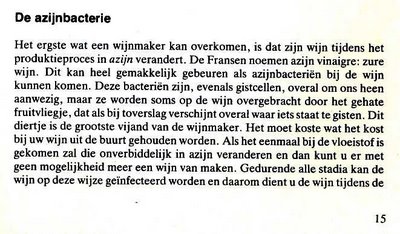De vier a vijf kilo gesplitte kwees gaan na het raspen in de keukenmachine de pan in. Deze twee pannen zijn maar net voldoende om water plus kwee te kunnen koken. Beslist niet meer dan 15 minuten zoals het recept aangeeft. Kook je te lang door dan is de kans groot dat de wijn troebel blijft.
After being grated in the kitchen whizz, the four to five kilos of quince go into the pan. These two saucepans are just big enough to hold the grated quince mass plus water. According to the recipe, boiling must on no account exceed fifteen minutes: if it boils for too long, chances are your wine will end up cloudy.

Dan gaat de massa heet in een perszak die over een 20 liter emmer gespannen zit.
Then the whole lot then goes into a muslin bag, which is stretched over a 20 litre bucket.

Als het meeste sap er doorheen gelopen is hang ik de zak op tot er niets meer uitdruppelt.
When most of the juice has run through, I hang up the bag until it has stopped dripping.


De uitgedruppelde filter/perszakken gaan in de fruitpers om de laatste liters er uit te halen.
Then the filter, or muslin bag goes into the wine press, to squeeze out the very last litres of juice.

De fruitvliegjes kwamen in grote getale op dit persen af, ik hoop dat ze geen schade aanrichten, want dat kunnen ze wel degelijk. Het is mij 25 jaar geleden overkomen: 20 liter azijn!!!!!
Zie onderstaand stukje uit mijn 'bijbel'.
Zie onderstaand stukje uit mijn 'bijbel'.
During the pressing, wineflies came swarming around in large numbers. I hope they won't cause any problems, because they can be a real menace. That's what happened to me 25 years ago: 20 litres of vinegar!!!!!
See below the relevant excerpt from my 'bible'.
 The vinegar bacteria
The vinegar bacteria
The very worst thing that can happen to a winemaker is that his wine changes to vinegar during the production process. The French for vinegar is 'vinaigre': literally 'sour wine'. This can happen very easily if vinegar bacteria are allowed to get into the wine. Like yeast cells, these bacteria are all around us, but sometimes they are transferred to the wine by the dreaded winefly, appearing as if by magic around anything which is fermenting. This creature is the winemaker's gretaest enemy. It is absolutely imperative that you keep it out of the way of your wine. Once the winefly has got into the must, it will be irrevocably transformed into vinegar and you'll never be able to use it for making wine. Wine can be infected in this way at all stages of the process and therefore you should....(keep the container covered by a thick cloth during the first fermentation).
See below the relevant excerpt from my 'bible'.
 The vinegar bacteria
The vinegar bacteriaThe very worst thing that can happen to a winemaker is that his wine changes to vinegar during the production process. The French for vinegar is 'vinaigre': literally 'sour wine'. This can happen very easily if vinegar bacteria are allowed to get into the wine. Like yeast cells, these bacteria are all around us, but sometimes they are transferred to the wine by the dreaded winefly, appearing as if by magic around anything which is fermenting. This creature is the winemaker's gretaest enemy. It is absolutely imperative that you keep it out of the way of your wine. Once the winefly has got into the must, it will be irrevocably transformed into vinegar and you'll never be able to use it for making wine. Wine can be infected in this way at all stages of the process and therefore you should....(keep the container covered by a thick cloth during the first fermentation).
Zulke nare beesten ja :-/
BeantwoordenVerwijderenIk weet niet of je iets aan deze tip hebt, maar deze wezens zuig ik (als enige wezens naast muggen) op met de stofzuiger. Misschien een idee om iemand te vragen met de stofzuiger paraat te staan tijdens dit werk?
Op zich geen slecht idee, ik probeerde het met blazen (compressor), maar dat doet ook stof ronddwarrelen.
BeantwoordenVerwijderenheel interesant maar ik zou een 8 jaar moeten wachten want ik heb dit jaar de keéappelpitten geplant.
BeantwoordenVerwijderenp.s
in duitsland maken ze er een schole van een soort sect.